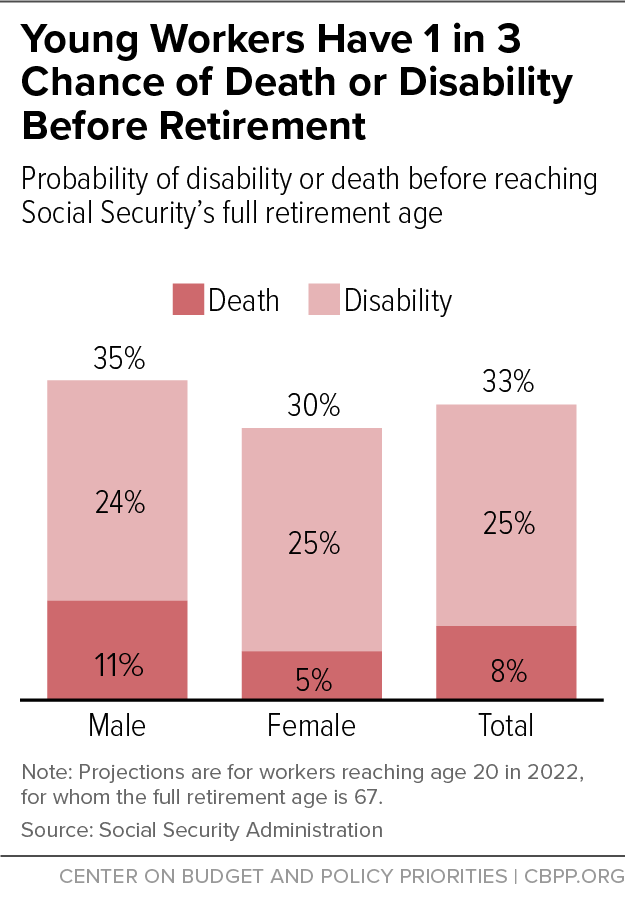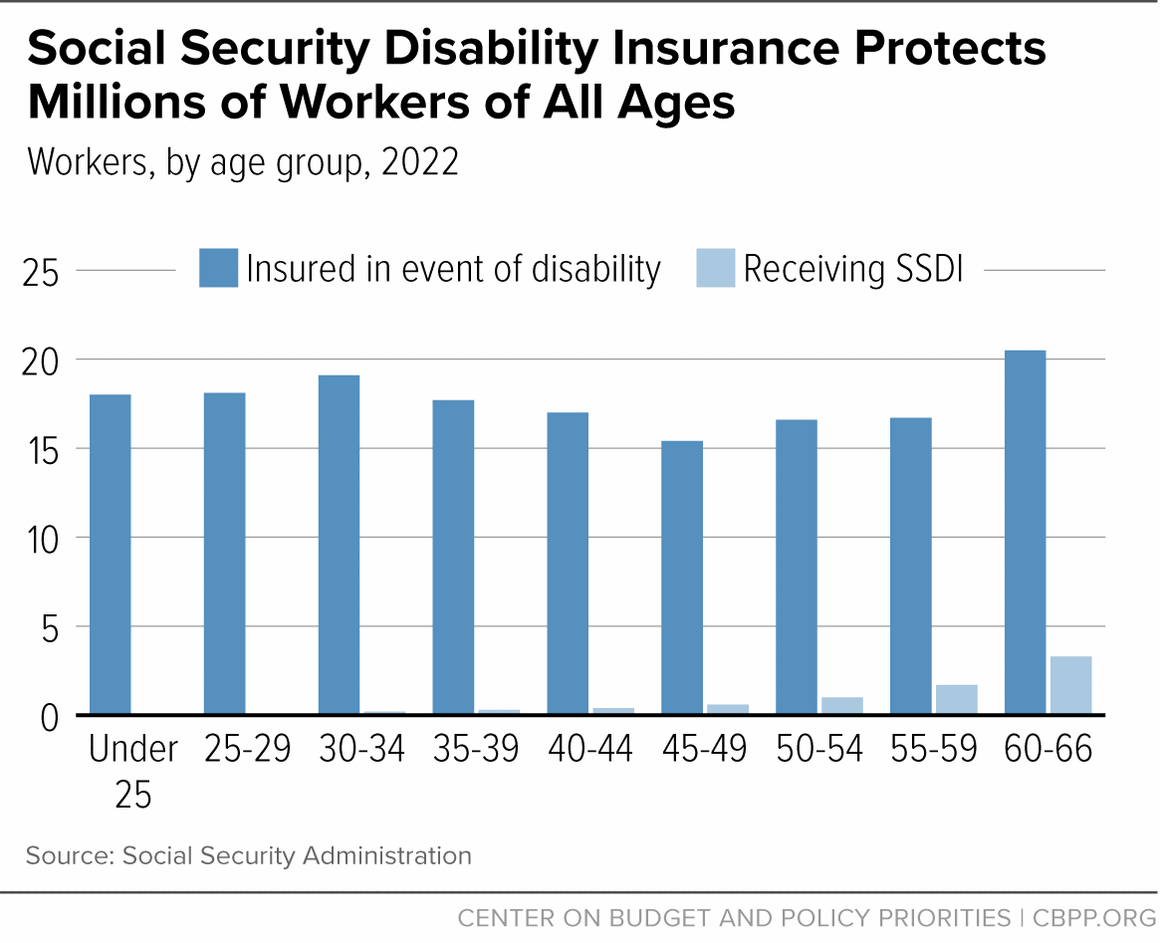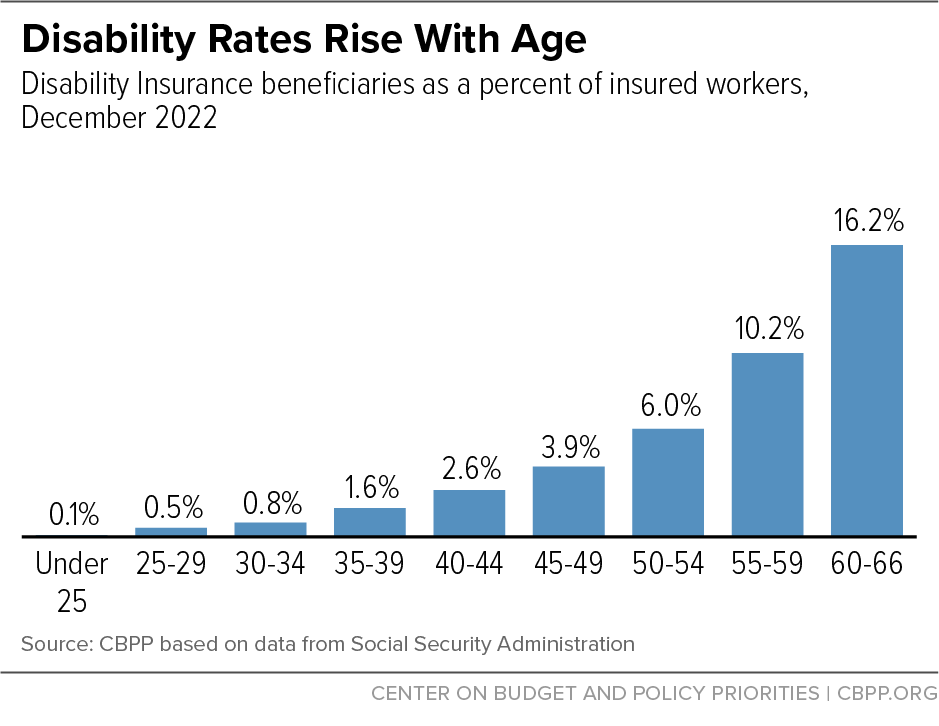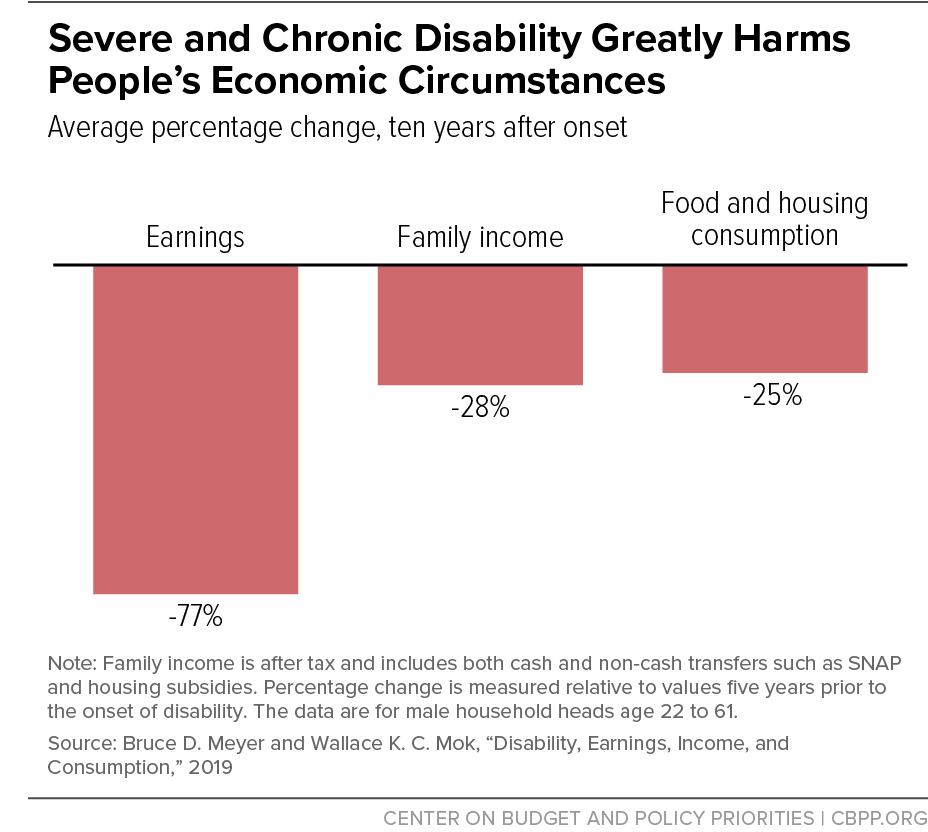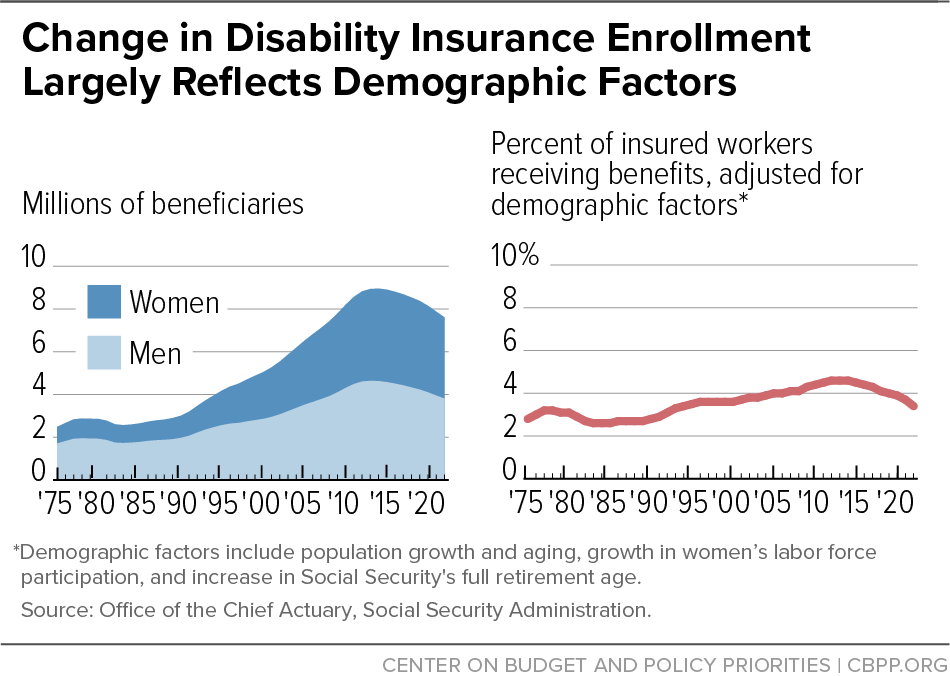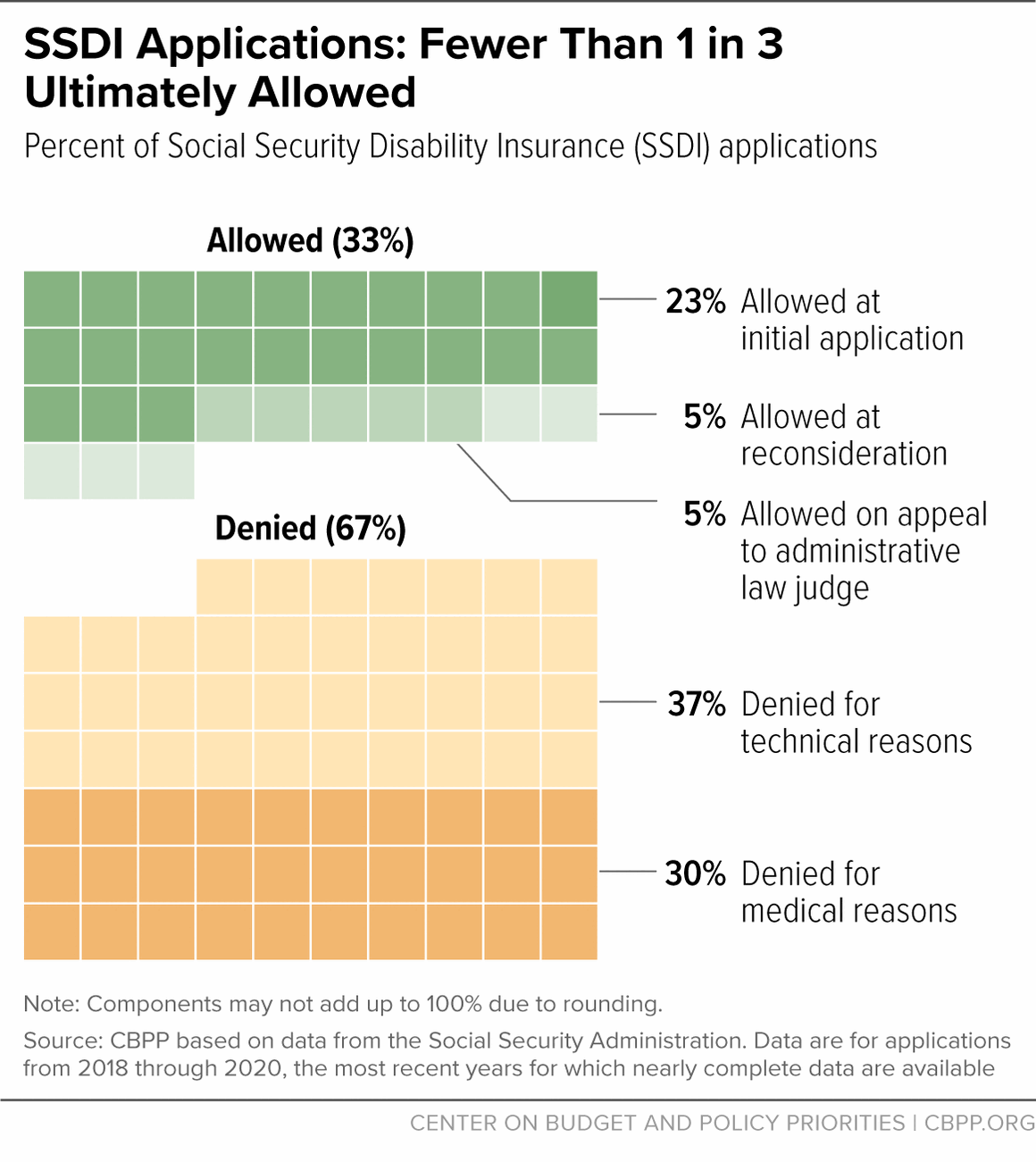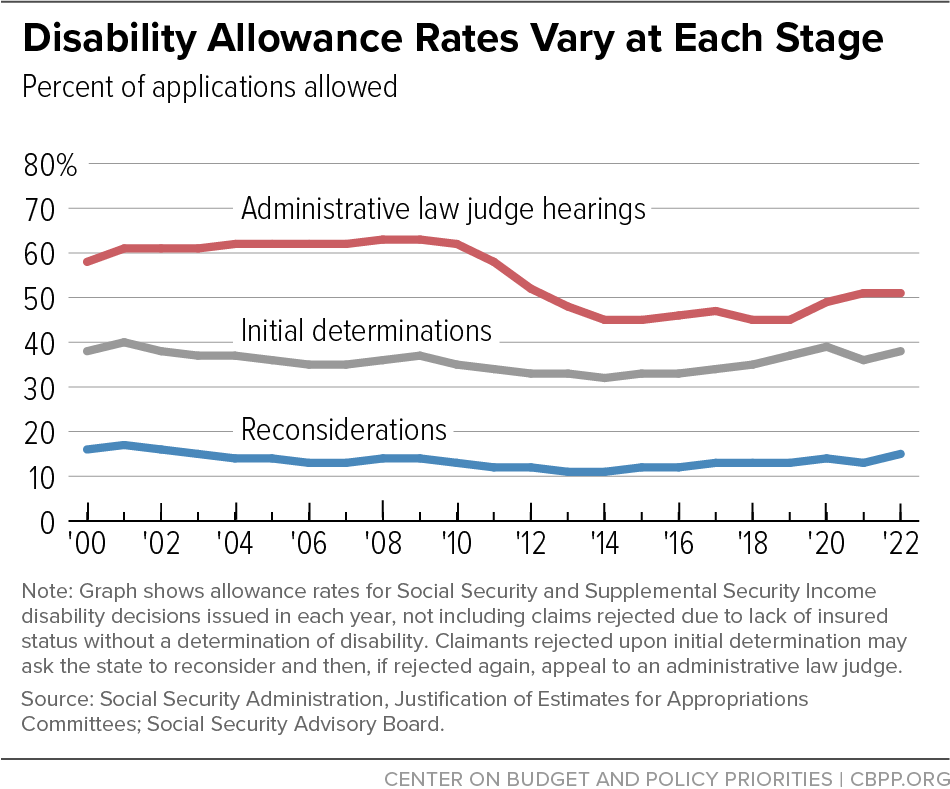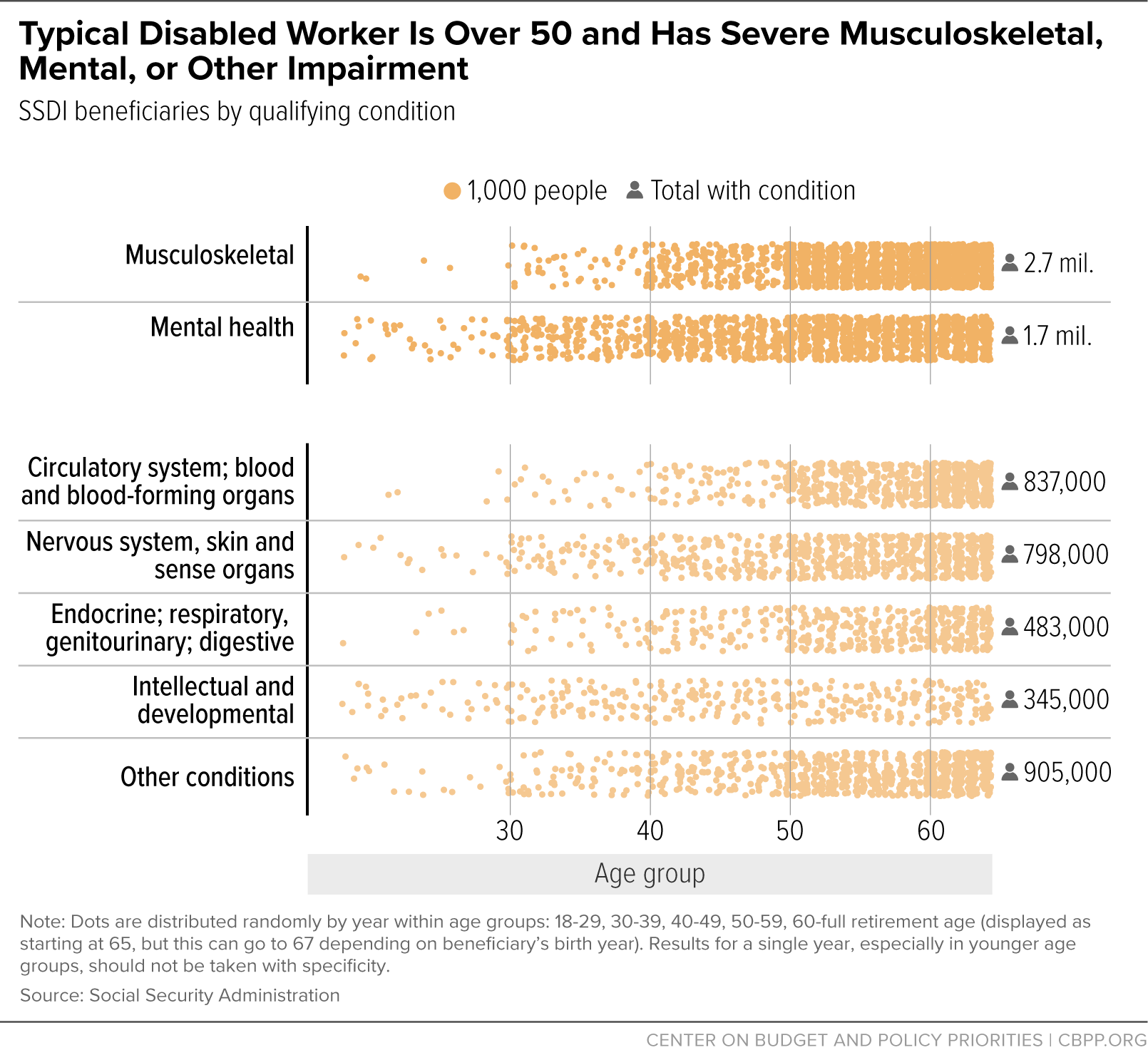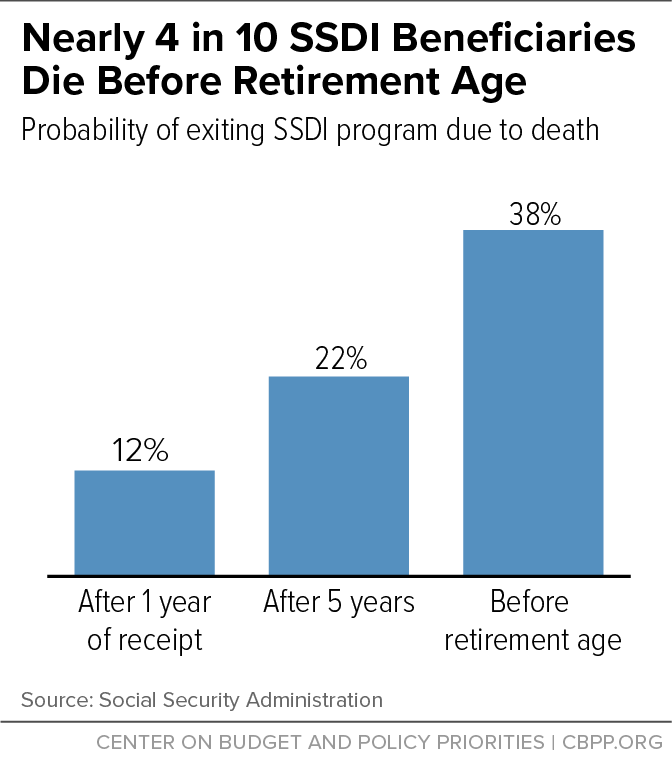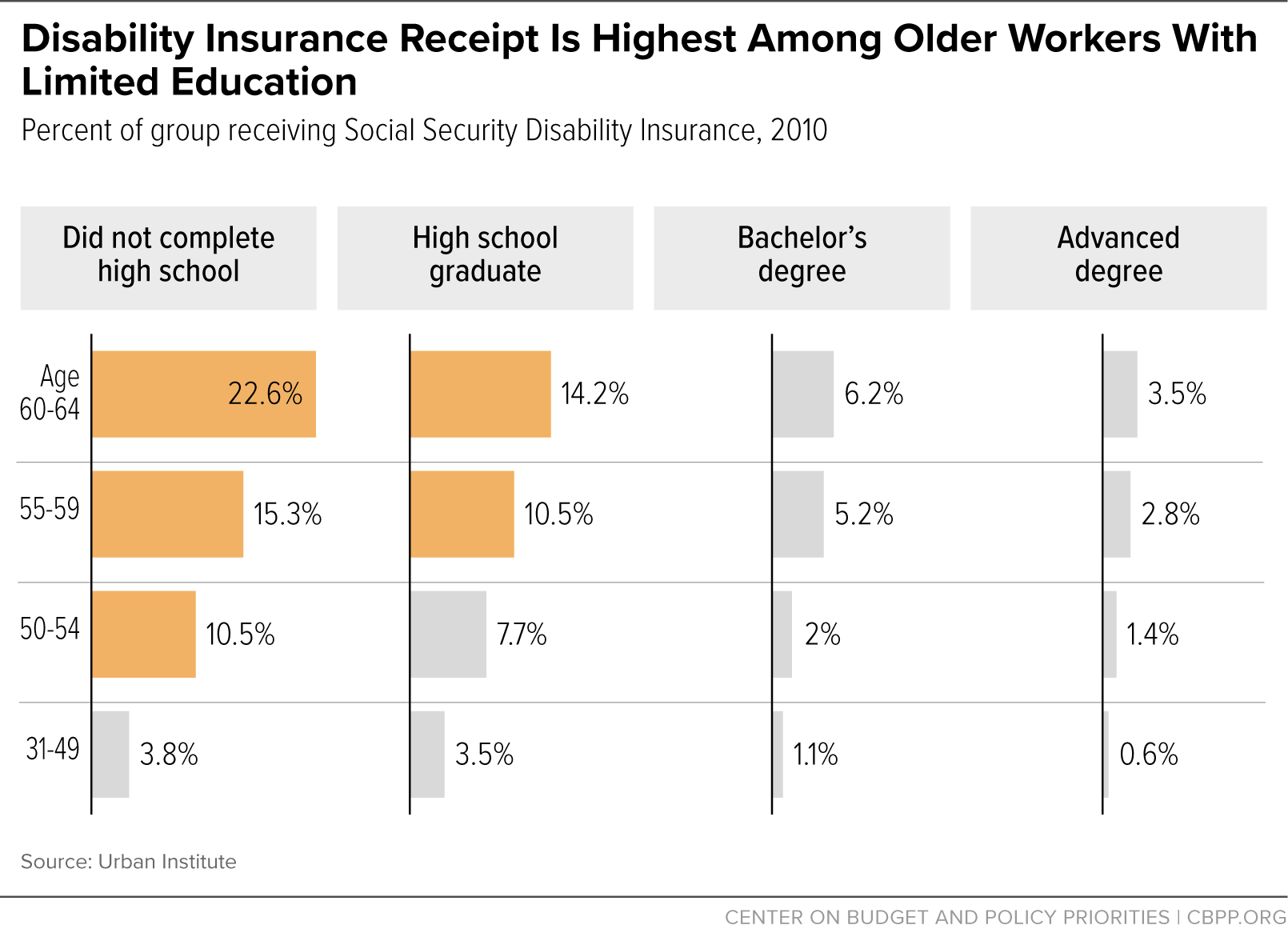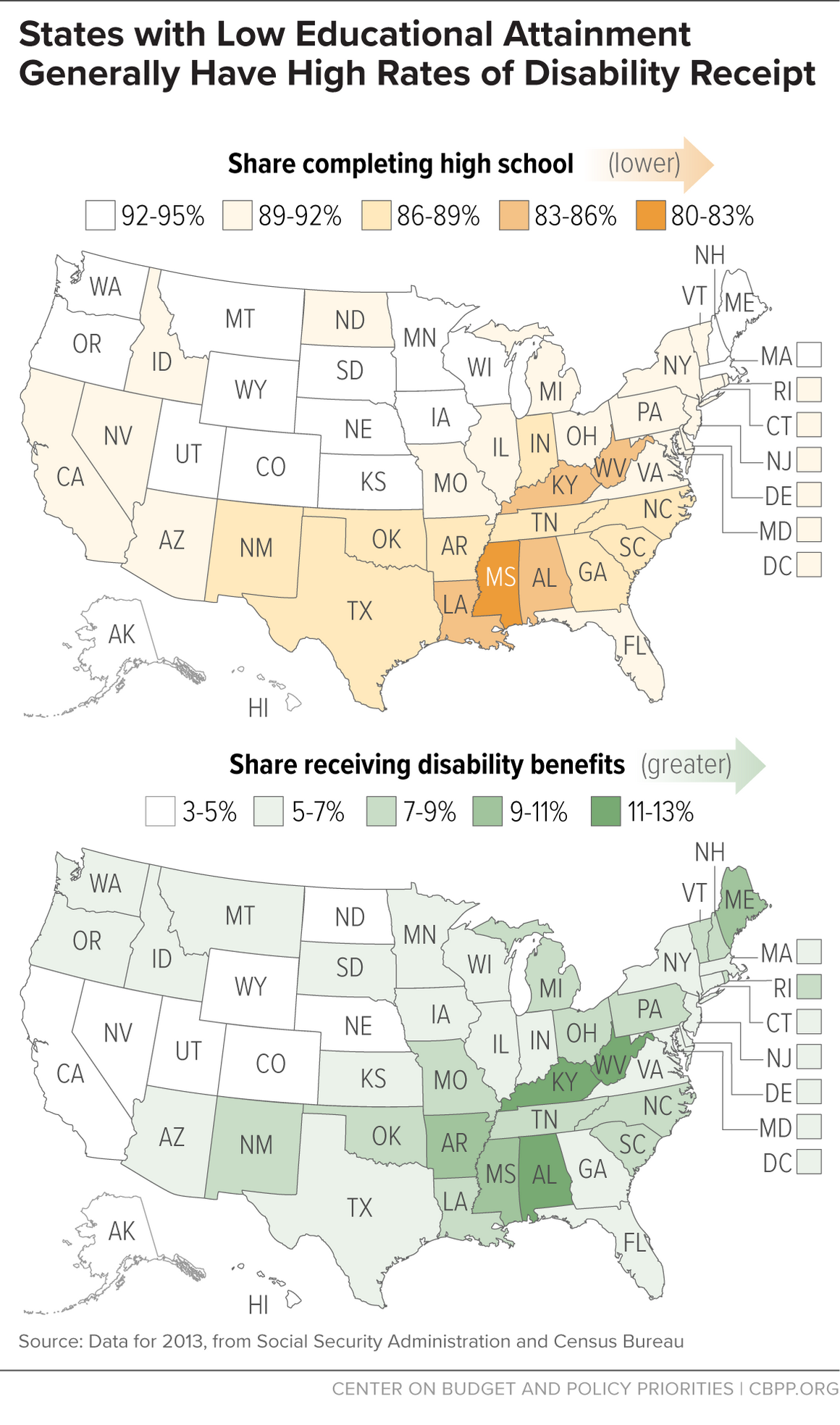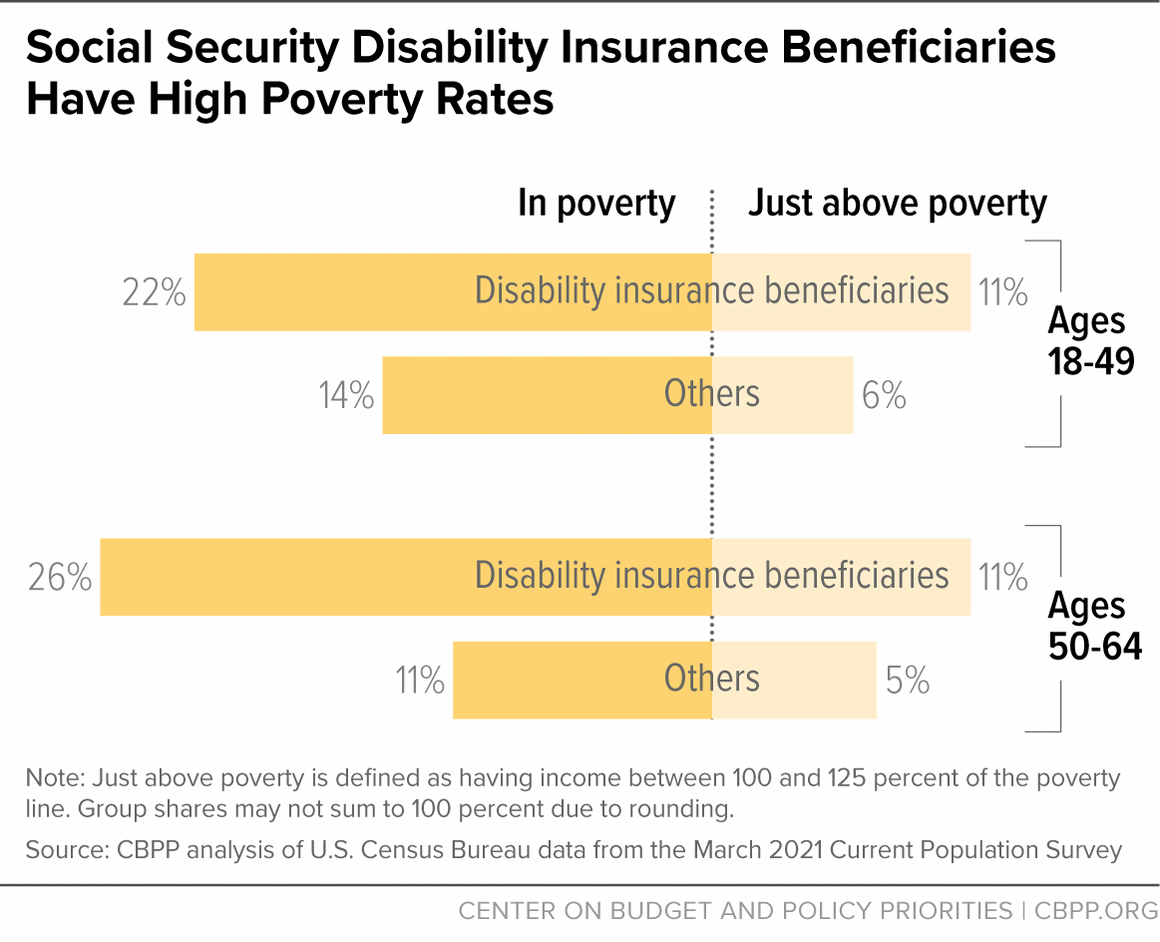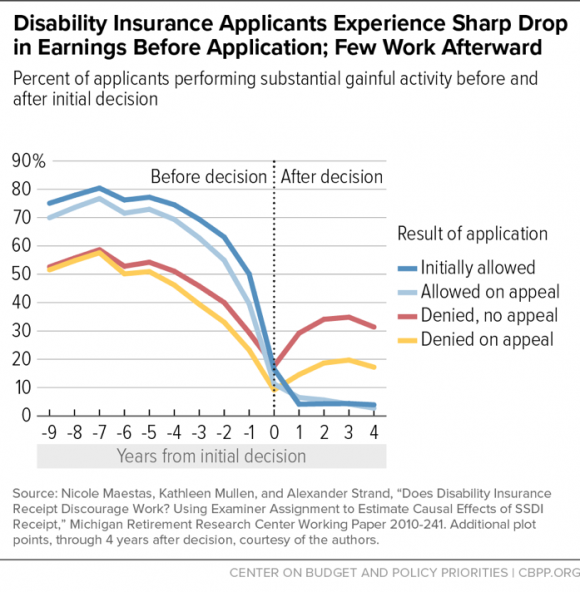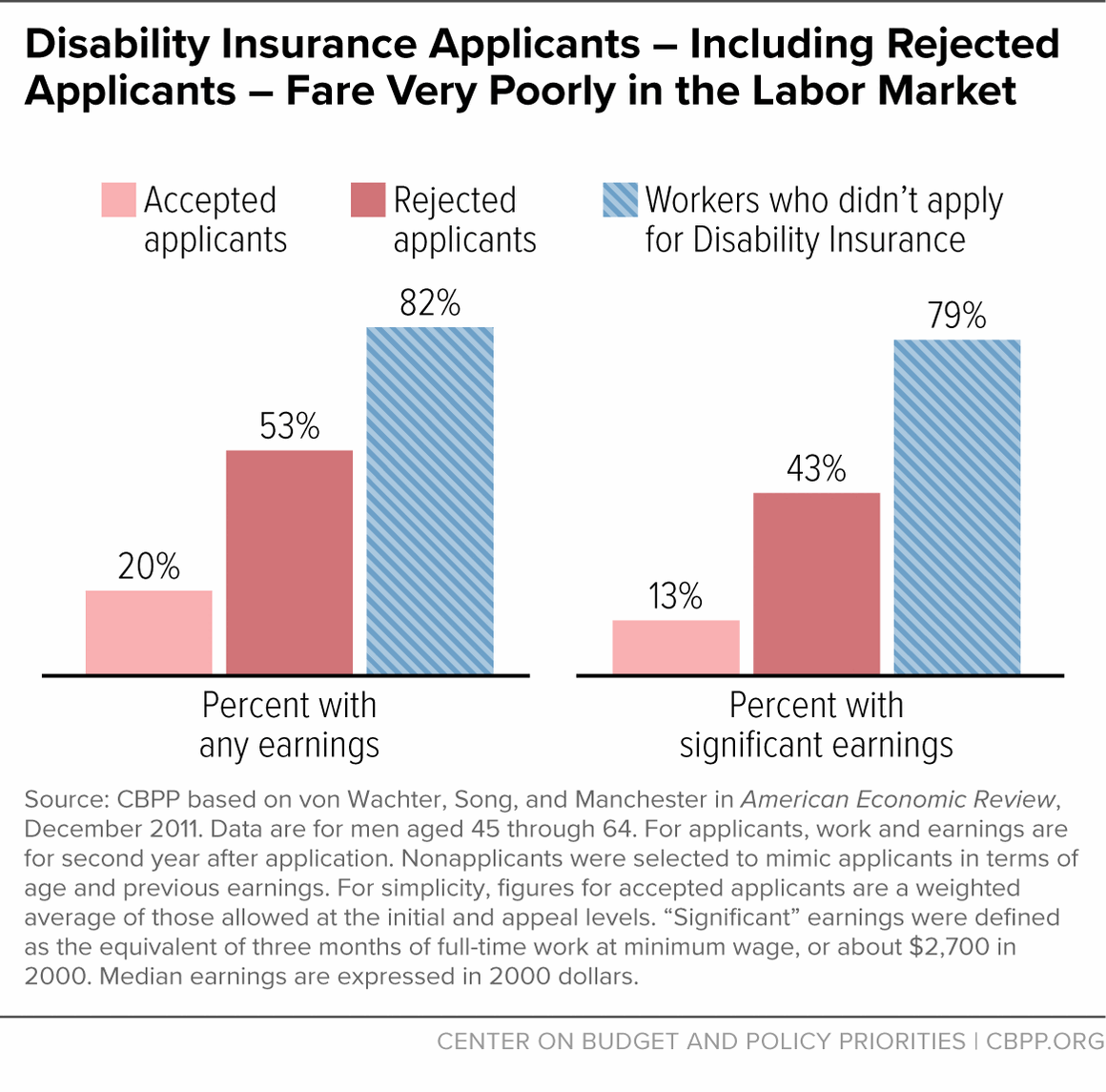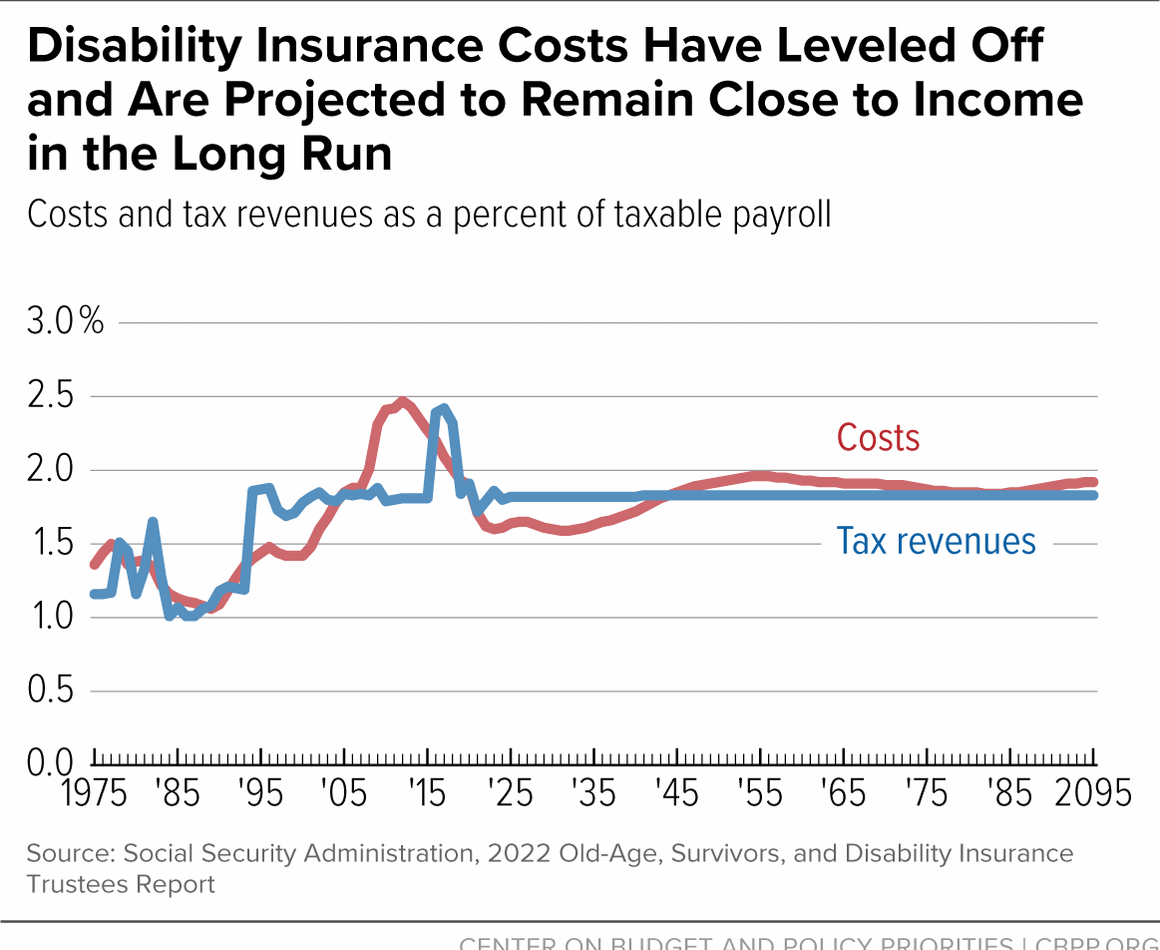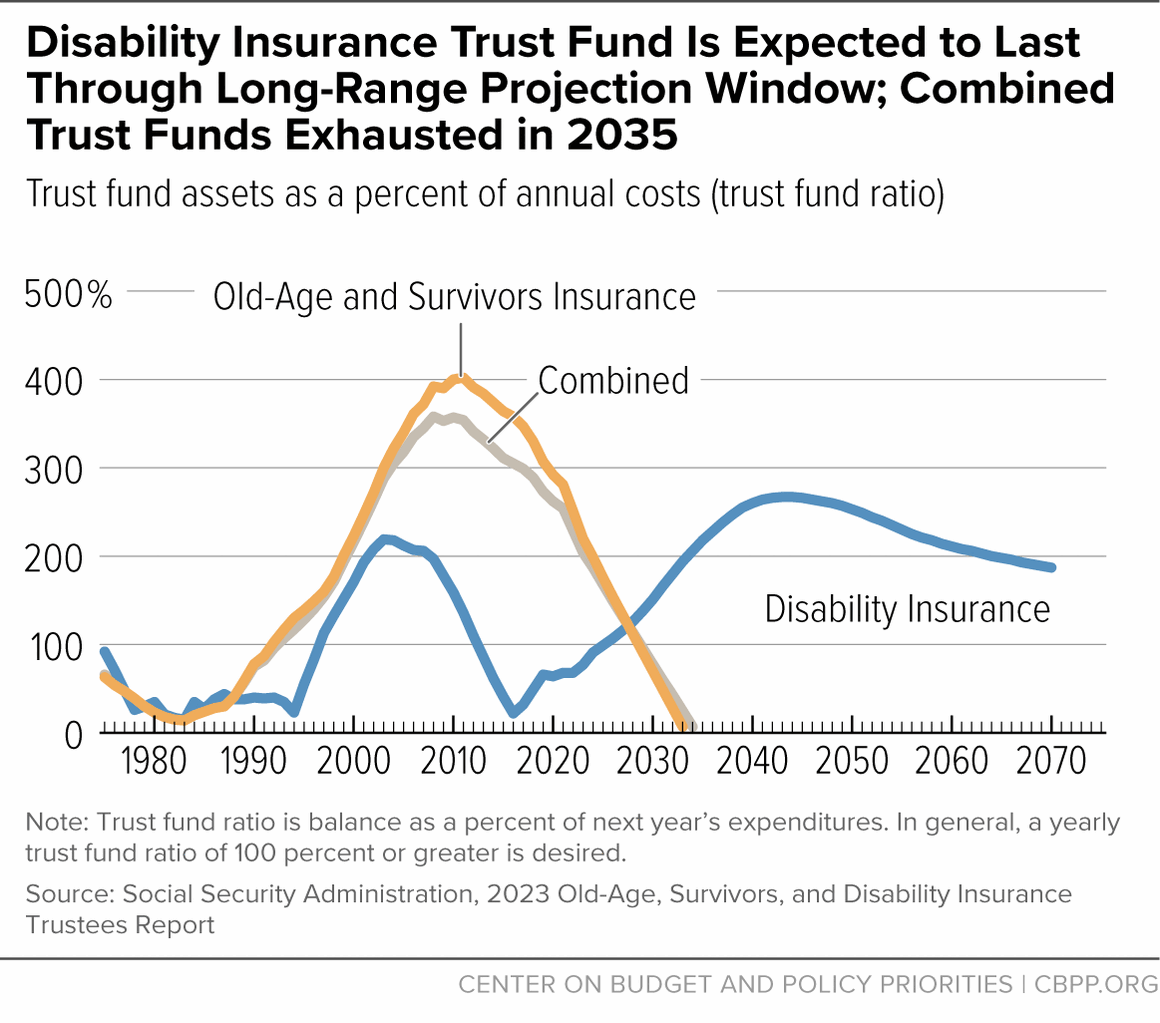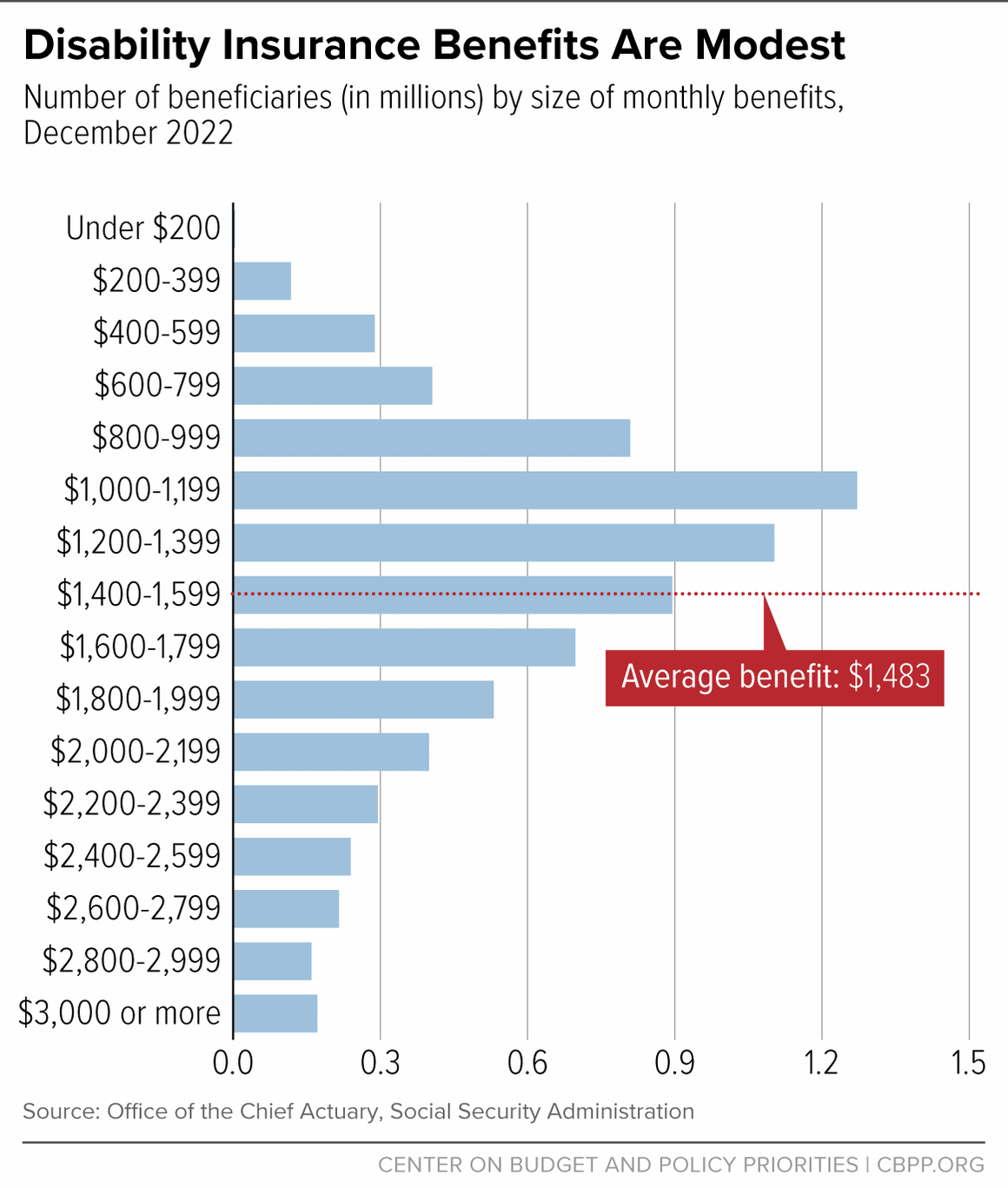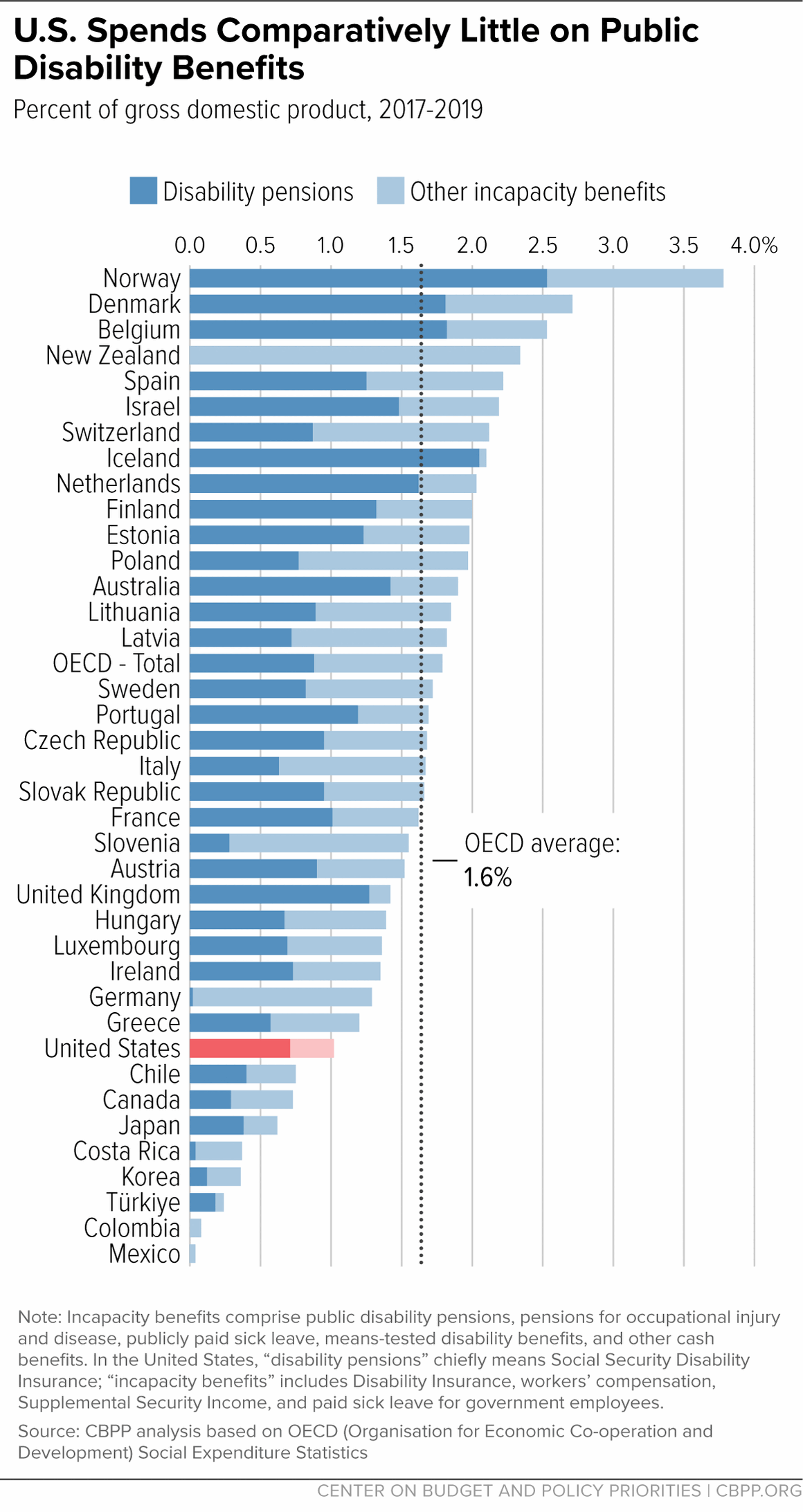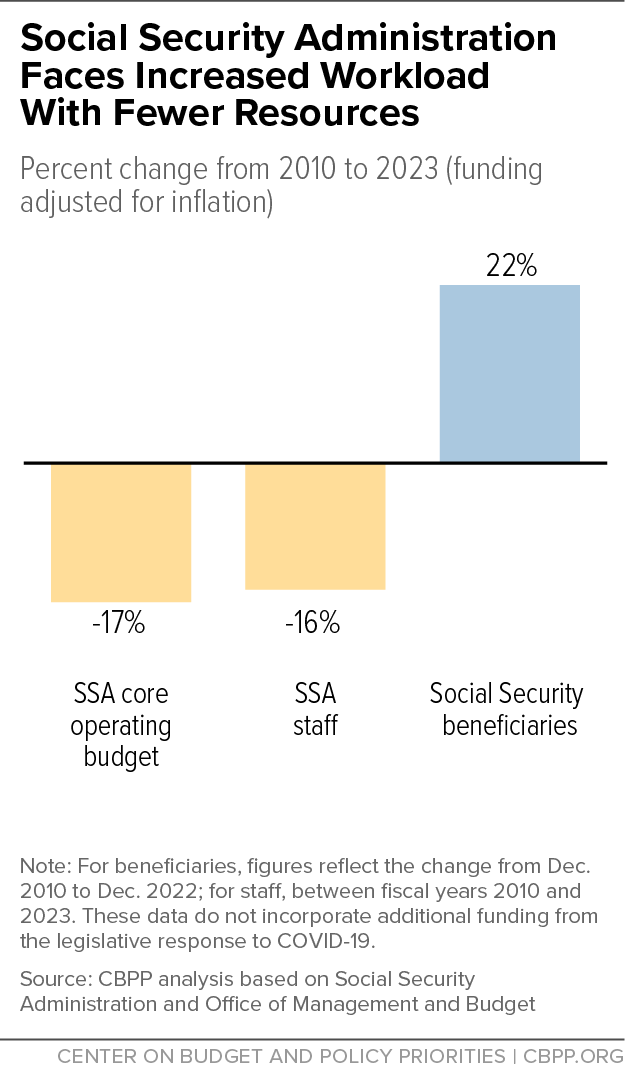- Home
- Social Security
- Social Security Disability Insurance
Chart Book: Social Security Disability Insurance
Introduction
Social Security Disability Insurance (SSDI), an integral part of Social Security, provides modest but vital benefits to workers who can no longer support themselves due to a serious and long-lasting medical impairment. The Social Security Administration (SSA) administers SSDI.
Some 7.4 million people received disabled-worker benefits from Social Security in October 2023. Payments also go to some of their family members: 89,000 spouses and 1.1 million children.
SSDI benefits are financed primarily by part of the Social Security payroll tax, and totaled about $143 billion in 2022. That’s roughly 2 percent of the federal budget and less than 1 percent of GDP. Employers and employees each pay an SSDI tax of 0.9 percent on earnings up to Social Security’s tax cap, set at $168,600 in 2024. The program’s financial transactions are handled through an SSDI trust fund, which receives payroll tax revenues and pays out benefits and which is legally separate from the much larger Social Security retirement fund. The most recent projections estimate that the SSDI trust fund will be fully funded over the 75-year long-range projection window, which extends to 2097.
Part I: Why Is Social Security Disability Insurance Important?
Part II: How Has SSDI Enrollment Changed Over Time?
Part IV: What Financing Issues Does SSDI Face?
Part I: Why Is Social Security Disability Insurance Important?
Social Security is much more than just a retirement program. A young person starting a career today has a roughly 1 in 3 chance of dying or qualifying for SSDI before reaching Social Security’s full retirement age.
SSDI is an earned benefit that offers vital protection to millions of workers. Through their payroll tax contributions, 160 million workers have earned SSDI protection in case of a severe, long-lasting medical impairment. About 7.4 million receive disabled-worker benefits from SSDI.
The risk of disability rises with age. People are more than twice as likely to receive SSDI at age 50 as at 40 — and more than twice as likely at age 60 as at 50. This reflects the underlying increase in disabling health conditions as people age. Several factors contribute. One is illnesses that are more likely at older ages, such as stroke or dementia. Another is degenerative diseases, which worsen over time, such as multiple sclerosis or ALS. And finally, people’s bodies simply break down with age, especially when they work in physically demanding jobs, leading to more debilitating musculoskeletal conditions or disabling injuries.
Disability can have devastating economic consequences. Not only can disability happen to anyone — especially with advancing age — but it greatly harms people’s economic circumstances. Their earnings, total family income, and spending on essentials like food and housing all fall significantly.
Part II: How Has SSDI Enrollment Changed Over Time?
The number of SSDI beneficiaries grew for most of the program’s history, mostly reflecting demographic factors: population growth and aging, and increasing women’s labor force participation. When SSDI enrollment peaked in the 1990s through the early 2010s, people in the large baby-boom generation — those born between 1946 and 1964 — were mostly in their 50s and 60s, years of peak risk for disability, but before Social Security’s full retirement age. And boomer women, unlike earlier generations of women, are overwhelmingly likely to have worked enough to be insured for SSDI.
Now the baby boomers have aged into or are approaching their retirement years, and SSDI enrollment has declined. (Disabled workers are converted to retired workers at the full retirement age — which is 67 for all new retirees, starting in 2022.)
When adjusted for these factors, the share of insured workers receiving SSDI benefits grew only modestly and is now declining.
Economic factors also affect disability applications — and, to a much lesser extent, awards. Economic downturns generally lead some workers to seek SSDI benefits, but a sour economy boosts applications by much more than actual awards because approval rates fall. The COVID-induced recession in 2020 departed from these trends; after SSA’s field offices closed, SSDI applications declined significantly, and awards fell as well. Even when a recession causes SSDI applications and awards to increase, it generally has a much larger effect on SSDI’s income, which falls when workers contribute less to Social Security because their earnings and employment have dropped.
SSDI enrollment is falling. Since 2014, the number of beneficiaries has fallen as demographic factors have shifted, and then as COVID closures of SSA field offices made it more difficult for applicants to access SSDI benefits. SSDI applications fell by 39 percent from 2010 to 2022, while awards fell by almost half. The total number of disabled worker beneficiaries dropped by nearly 1.4 million from its peak in 2014 to 2022. Social Security’s trustees project that the share of people in the United States receiving SSDI will rise somewhat over the next 20 years and then remain stable.
Part III: Who Receives SSDI?
Eligibility criteria are strict, and most SSDI applicants are rejected. Applicants for SSDI benefits must:
- Be insured for disability benefits (essentially, they must have worked for at least one-fourth of their adult life and five of the last ten years).
- Have a severe, medically determinable physical or mental impairment that is expected to last 12 months or result in death, based on clinical findings from acceptable medical sources.
- Be unable to perform “substantial gainful activity” (any job that generates earnings of $1,550 per month in 2024 for most people, $2,590 for blind people) anywhere in the national economy — regardless of whether such work exists in the area where the applicant lives, whether a specific job vacancy exists, or whether they would be hired.
Lack of education and low skills are factored into eligibility for older, severely impaired applicants who can’t realistically change careers — but not for younger applicants.
There is a five-month waiting period for SSDI, but Supplemental Security Income may be available during that period for beneficiaries with little or no income and assets.
SSA denies applicants who are technically disqualified (chiefly because they haven’t worked long enough) and sends the rest to state disability determination services (DDS) for medical evaluation. Applicants denied at that stage may ask for a reconsideration by the same state agency and then appeal to an administrative law judge (ALJ) at SSA. Some 44 percent of people who get an initial denial pursue an appeal.
Ultimately, if we follow a cohort of applicants to the end of their application and appeal process, fewer than 1 in 3 are awarded benefits. Among applicants who meet the program’s technical requirements, slightly more than half are found medically eligible for SSDI.
SSA monitors disability decisions at all stages of the process. SSA conducts ongoing quality reviews at all stages of the application and appeal process. Many reviews occur before any benefits are paid, thus reducing errors.
Allowance rates at the initial application and reconsideration stages have been relatively stable over the last two decades. However, allowance rates dropped noticeably at the ALJ stage from 2010 to 2014, as SSA increased oversight of hearings and altered the disability regulations. (These allowance rates reflect decisions made in a particular year, on applications filed in different years, so they aren’t directly comparable to those derived from following a cohort of applicants through their entire process.)
Allowance rates remain higher at the ALJ stage than at the initial stage, however. This is partly because ALJs often see claimants whose condition has deteriorated in the year or more since their application was first turned down and whose application is better documented (typically with the help of an attorney) than at the DDS stage.
SSDI beneficiaries are mostly older and have severe physical or mental impairments. The typical SSDI beneficiary is in their 50s — more than three-quarters are over age 50, and more than 4 in 10 are 60 or older. SSDI beneficiaries have a wide variety of disabilities. Musculoskeletal conditions like osteoarthritis and scoliosis, which often markedly worsen with age and repetitive strain, are the leading cause of disability among beneficiaries aged 50 and older. Severe mental disorders, like schizophrenia and bipolar disorder, which typically manifest in young adulthood, are the leading cause of disability among beneficiaries younger than 50.
SSDI beneficiaries experience high death rates. Mortality among SSDI beneficiaries aged 50 and over — who dominate the program’s enrollment — is two to six times the average for their age group. In fact, more than 1 in 10 SSDI beneficiaries die within one year of their award, more than 2 in 10 within 5 years, and nearly 4 in 10 before reaching full retirement age.
People with limited education are much likelier to collect SSDI. Education is an indicator of socioeconomic status, which is highly correlated with physical and mental health, disability, and longevity. Those with limited education and skills also generally have to do physical work and can’t switch to something sedentary. Thus, people without a college degree are far more likely to qualify for SSDI.
Disability beneficiaries exhibit a distinct geographic pattern. States with low high school completion rates, more older residents, few people who are immigrants, and a blue-collar industry mix tend to have more SSDI beneficiaries. Isolated pockets with unusually high rates of receipt are extreme outliers.
Many SSDI beneficiaries are below the poverty line. Poverty rates are roughly twice as high for SSDI beneficiaries as for others — even when including their benefits. Overall, about one-fifth of all disabled-worker families are poor; without SSDI, nearly half would be.
SSDI beneficiaries have limited work capacity. SSDI applicants typically suffer a sharp drop in earnings before turning to the program. The most severely impaired, who are awarded benefits, seldom work afterward. Even rejected applicants fare poorly in the labor market afterward — more evidence that the program’s eligibility criteria are strict.
Although SSDI allows beneficiaries to supplement their benefits through work, few can do so. Program rules allow and encourage SSDI beneficiaries to earn up to the “substantial gainful activity” level ($1,550 a month in 2024, about 40 percent of median earnings for a high school graduate with no college). Beneficiaries may earn unlimited amounts for a nine-month trial work period and a subsequent three-month grace period before benefits are suspended. Even then, they may return to SSDI if their earnings fall. And former beneficiaries who’ve returned to work may keep their Medicare (which is available to SSDI beneficiaries after two years) for seven and a half years after their cash benefits stop.
But most SSDI beneficiaries can’t work. Of beneficiaries who were tracked for ten years after qualifying, only about 28 percent did any paid work, 7 percent had benefits suspended for at least one month because of work, and 4 percent had benefits terminated because of sustained work.
It’s useful, too, to compare SSDI beneficiaries with rejected applicants and with people who’ve never applied for benefits. One careful study found that only one-fifth of beneficiaries aged 45 to 64 — and only about half of rejected applicants — had any earnings two years after application, and even fewer had significant earnings. In contrast, non-disabled workers of the same age (who didn’t seek SSDI benefits) were likely to work and had substantial earnings.
Part IV: What Financing Issues Does SSDI Face?
SSDI costs have leveled off, and its trust fund is projected to stay fully funded for at least 75 years. SSDI costs stabilized as the baby boomers moved from their peak disability-prone years to their peak retirement years. As for its financing, the payroll taxes that workers contribute out of every paycheck fund most of SSDI’s costs. In addition, SSDI has built up trust fund reserves, which Social Security’s trustees estimate will last at least through 2097.
Though the SSDI trust fund has enough funding to last through the 75-year long-range projection window, policymakers must address overall Social Security financing before then. Overall, Social Security can pay full benefits for ten more years, the trustees’ annual report shows, but then faces a significant — though manageable — funding shortfall. Policymakers should address Social Security’s long-term shortfall primarily by increasing Social Security’s tax revenues. Social Security will require an increasing share of our nation’s resources as the population ages, and polls show a widespread willingness to pay more to strengthen the program.
SSDI benefits are modest. The average disabled-worker benefit is about $1,483 a month, and 80 percent of beneficiaries get less than $2,000 a month.
Most beneficiaries — especially unmarried ones — rely on SSDI for most of their income. SSDI benefits replace about half of past earnings for a median beneficiary.
Most other advanced countries spend more than the United States on disability benefits. U.S. eligibility rules are strict, and benefit levels are modest. The Organisation for Economic Co-operation and Development (OECD) reports that the United States has some of the most stringent eligibility criteria for disability benefits among advanced economies. OECD statistics confirm that the United States spends less on disability benefits (as a share of the economy) than most other advanced countries.
Social Security’s administrative funding is inadequate. The Social Security Administration’s administrative funding (which, unlike Social Security benefits, is subject to annual appropriation) has declined in real terms since 2010, even as enrollment has climbed. That has impaired customer service by increasing wait times at field offices and on the phone. Staff cutbacks have also led to growing delays in processing applications or changing benefits when a beneficiary’s circumstances change.
Customer service problems at SSA hit disability beneficiaries especially hard, because these claims require more attention from staff. In 2023, the average wait for an initial disability decision at SSA reached an all-time high of over seven months — more than three months longer than before the pandemic. Over 1 million disability claims are pending at DDS agencies. More people waiting for disability decisions, and longer wait times for the decisions, take a toll on individuals, families, and communities. Without additional funding, these unacceptable wait times will continue to grow.
SSA closed to in-person service from March 2020 to April 2022 due to the COVID-19 pandemic. This disruption in service added to the problems caused by inadequate SSA funding.
